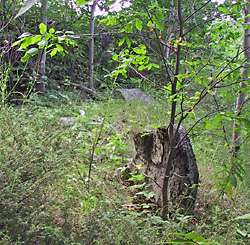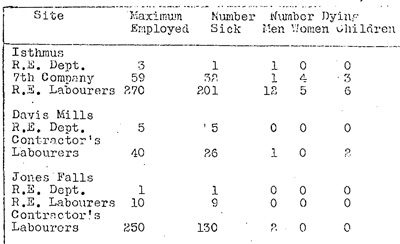Rideau Myths
by
Ken W. Watson
Note: This article first appeared in the Fall/Winter 2018 edition of Rideau Reflections, the newsletter of the Friends of the Rideau (www.rideaufriends.com).
| |  |
| |
Old Burying Ground at Jones FallsNot much can be seen in this photo and that’s the point – this is part of the old burying ground at Jones Falls. It saw continued use to about the 1850s and then was abandoned and forgotten until a gravel pit was opened up on this spot a century later (by workers unaware of this spot’s former use). Work on the pit was stopped when skeletons were discovered (a story recounted in Tales of the Rideau).
Photo by: Ken W. Watson |
For years now I’ve been trying, with limited success, to beat down misconceptions about the building of the Rideau Canal. Certain erroneous beliefs are persistent. Many people still think that the malaria that affected the workers was brought to this area by British soldiers and that it was unique to the Rideau – that’s incorrect on both counts. Many people think that workers who died were buried in unmarked graves – they weren’t. Many people think that the Rideau construction camps were like a gulag with a callous disregard for the worker – they weren’t. We’ll look at a few examples.
The tale that malaria was brought here by British soldiers who had served in malaria-prone areas comes about from a non-understanding of what malaria is. Malaria is a parasite that needs two hosts, humans and mosquitoes (a particular type that bites more than once), with a minimum number of each infected to sustain the malarial cycle. There are five varieties of the malaria parasite, four of which are located in tropical areas where mosquitoes are present all year. There is also a temperate variety, Plasmodium Vivax, which survives in colder climates where mosquitoes are only present for part of the year. P. Vivax can do this since it has the ability to stay dormant in a human liver until the mosquitoes are out and biting again. This type of malaria dates back to the late 1700s in Upper Canada (it was originally imported into North America from Europe). It was already well established in Kingston and Perth by the time canal construction started. P. Vivax has a low mortality rate compared to the most common and much more virulent form of tropical malaria (P. Falciparum). On the Rideau, about 60% of the workforce caught the disease each year and about 2% died. Deaths were likely not due to the malaria alone, it interacted with common health issues of the day (dysentery, tuberculosis, etc.) and that increased mortality.
The unmarked graves myth is from a simple misunderstanding of burials and cemeteries. For the last 150 years or so, people in this area have been buried in established church/community cemeteries with most graves marked with a carved stone headstone. So that expectation, when looking at the older canal-era cemeteries where we see no markers, or only a few apparently scattered fieldstones, led to the erroneous conclusion that the original graves were unmarked, or only marked with a blank fieldstone. This myth continues to this day, a recent brochure about the newly re-named Royal Sappers and Miners Cemetery in Newboro, states “An unknown number of civilian workers are buried at the cemetery, with their grave sites originally marked by unidentified stones.” That is incorrect. We know that funerals were held for those who died (we have a few descriptions of those). As would have been common in the era, a wooden marker was placed at the head of the grave, with the person’s name on it. Also common in that era was to place a fieldstone to mark the foot of the grave. The wooden markers have long since rotted away, leaving only the footstones as evidence that a grave was there.
In tackling the concept that there was a callous disregard for the workers (the gulag concept) we have three issues; cultural bias in historical interpretation, evaluating actions in the past against the standards of today and, as noted above, a misinterpretation of how people were buried at canal burial sites. Rideau work camps were quite similar to the timber camps of the day. The contractor built log structures; cabins, cookhouses and bunkhouses, to house and feed the workers. We have several period paintings showing those. The workers at some sites also built their own cabins to house their families. Some worksites grew into small communities with taverns and schools. When a worker or family member died, a funeral was held and they were buried in marked graves. If a worker died by accident, an inquest was held, this was the law in Upper Canada (accidents were actually quite low for a project of the Rideau’s magnitude). The workers were paid in cash (silver coins), that was a requirement of the British Commissariat. The work was hard but most of the deaths were by disease which included regular fevers, dysentery, tuberculosis, and complications of those interacting with malaria.
We see Lt. Colonel By trying to mitigate the problems as best he could – no one wanted to see workers get sick or die. While we see those numbers as high (as many as 1,000 men, women and children over the 5 years of construction), they pale in comparison to deaths by disease in urban areas – Montreal for instance saw almost 2,000 deaths by cholera in 1832 and many additional deaths due to cholera in 1834.
| |  |
| |
Some 1830 Malaria NumbersThis compilation was done from Colonel By’s “return of sick” for the period August 1 to September 30, 1830. Although malaria was noted by Dr. Christie in his medical report for the Rideau in 1827, the first big infection by malaria occurred in hot summer of 1828 (lots of Anopheles mosquitoes, particularly in the southern sections of the Rideau). It then re-occurred every summer to 1831. When the workforce left, so did most of the malaria since there were not enough humans to sustain the cycle. In 1834, John Redpath brought his family to Jones Falls to escape the cholera epidemic in Montreal (which had killed his wife), since Jones Falls was now a healthier place than Montreal.
Table from “Malaria on the Rideau Canal, 1826-32” by Dianne Patychuk, 1979. Numbers from Library and Archives Canada, MG12, WO44, Vol.18, p.482.
|
We see some cultural groups (i.e. Irish) commemorated more than others (i.e. French Canadian). Everyone was in the same boat on the Rideau – disease and death played no cultural favourites; the Royal Engineers, the contractors, the British soldiers, the tradesmen (multi-ethnic) the labourers (Irish and French-Canadian) and the women and children on the worksites, all got sick and had similar mortality rates, all were living and working in the same conditions. Contractor John Redpath at Jones Falls said in a letter written on December 31, 1831 in referencing malaria: “I caught the disease both the first and second year [1828 & 29] missed the third [1830] but this year had a severe attack of Lake Fever – which kept me to bed for two months and nearly two months more before I was fit for active service.” Redpath noted that if he’d known what he was getting into, he wouldn’t have taken the job “Nothing can compensate for the worse of health so no inducement whatever would stimulate one to a similar undertaking.” It was tough for everyone.
When we measure Colonel By’s actions against the norms of the day he comes out looking very good. He bucked a number of conventions and regulations in trying to help the workers. He was a man ahead of his time in many aspects, from engineering to human compassion. There was a human cost in building the Rideau Canal and we should never forget that. But we also shouldn’t view the building of the Rideau Canal as a project that had a callous disregard for human life – that’s simply not true. They did the best they could given the circumstances of the times.
-Ken W. Watson
|